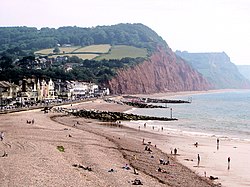Sidmouth
| Sidmouth | |
|---|---|
 Looking east along Sidmouth Beach |
|
| Sidmouth shown within Devon | |
| Population | 12,569 |
| OS grid reference | SY124874 |
| District | |
| Shire county | |
| Region | |
| Country | England |
| Sovereign state | United Kingdom |
| Post town | Sidmouth |
| Postcode district | EX10 |
| Dialling code | 01395 |
| Police | Devon and Cornwall |
| Fire | Devon and Somerset |
| Ambulance | South Western |
| EU Parliament | South West England |
| UK Parliament | |
Sidmouth /ˈsɪdməθ/ is a town situated on the English Channel coast in Devon, South West England, 14 miles (23 km) east of Exeter. In 2004, it had a population of about 15,000, of whom 40% were aged 65 or over. By the time of the 2011 census the population was 12,569. It is a tourist resort and a gateway to the Jurassic Coast World Heritage Site. A large part of the town has been designated a conservation area.
Sidmouth appeared in the Domesday Book as Sedemuda, meaning "mouth of the Sid". Like many such settlements, it was originally a fishing village. Although attempts have been made to construct a harbour, none has succeeded. A lack of shelter in the bay prevented growth as a port.
Sidmouth remained a village until the fashion for coastal resorts grew in the Georgian and Victorian periods of the 18th and 19th centuries. A number of Georgian and Regency buildings still remain. In 1819, George III's son Edward, Duke of Kent, his wife, and baby daughter (the future Queen Victoria) came to stay at Woolbrook Glen for a few weeks. In less than a month he had died from an illness. The house later became the Royal Glen Hotel; a plaque on an exterior wall records the visit. In 1874, Sidmouth was connected to the railway network by a branch line from Sidmouth Junction, which called at Ottery St Mary and Tipton St John. This was dismantled in 1967 as a result of the Beeching Axe.
...
Wikipedia

